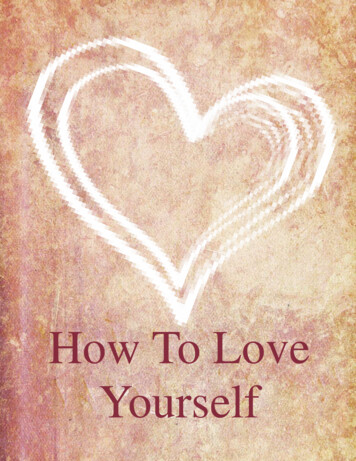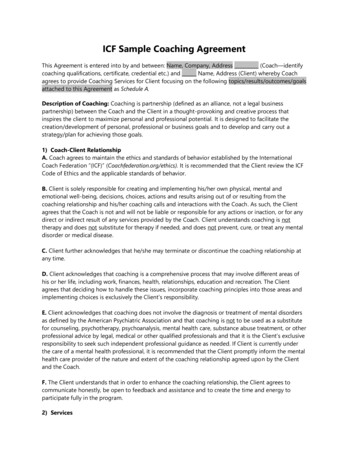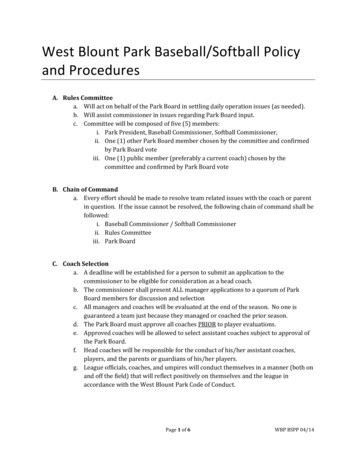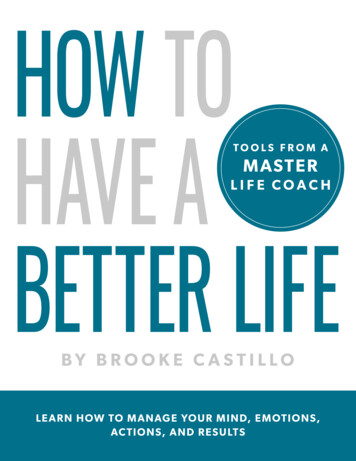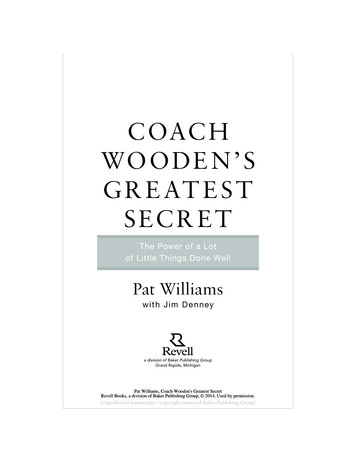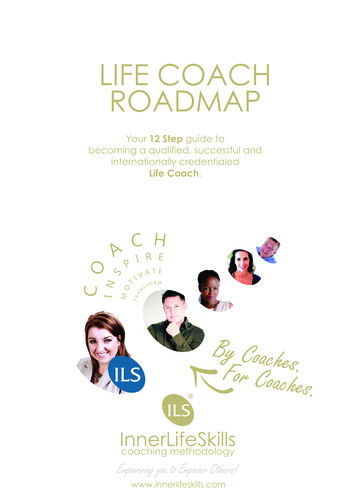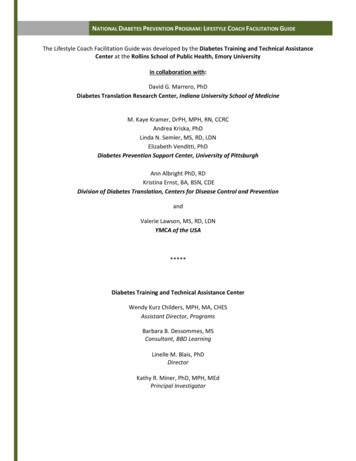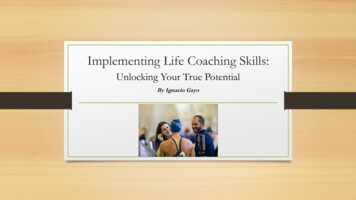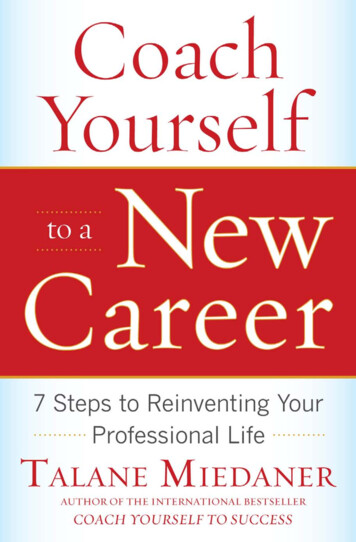
Transcription
“Wow, what a toolbox for success! Talane’s book has everything you needto create a career that will support you in living a soulful life.”—Cheryl Richardson, author of Life MakeoversCoachYourselfto aNewCareer7 Steps to Reinventing Your Professional LifeTALANE MIEDANERNew York Chicago San Francisco Lisbon London Madrid Mexico CityMilan New Delhi San Juan Seoul Singapore Sydney Toronto
Copyright 2010 by Talane Miedaner. All rights reserved. Except as permitted under the United States CopyrightAct of 1976, no part of this publication may be reproduced or distributed in any form or by any means, or storedin a database or retrieval system, without the prior written permission of the publisher.ISBN: 978-0-07-170672-8MHID: 0-07-170672-0The material in this eBook also appears in the print version of this title: ISBN: 978-0-07-170309-3, MHID:0-07-170309-8.All trademarks are trademarks of their respective owners. Rather than put a trademark symbol after every occurrence of a trademarked name, we use names in an editorial fashion only, and to the benefit of the trademark owner,with no intention of infringement of the trademark. Where such designations appear in this book, they have beenprinted with initial caps.McGraw-Hill eBooks are available at special quantity discounts to use as premiums and sales promotions, or foruse in corporate training programs. To contact a representative please visit the Contact Us page at www.mhprofessional.com.The instructions and advice in this book are not intended as a substitute for psychological counseling. The authorand the publisher disclaim any responsibility or liability resulting from the actions advocated or discussed in thisbook. In the interest of preserving client confidentiality, all clients names and, in some cases, identifying characteristics have been changed except where permission to use fi rst and last names has been granted. The scenarios,situations, and results are real.TERMS OF USEThis is a copyrighted work and The McGraw-Hill Companies, Inc. ( McGraw-Hill ) and its licensors reserve allrights in and to the work. Use of this work is subject to these terms. Except as permitted under the Copyright Actof 1976 and the right to store and retrieve one copy of the work, you may not decompile, disassemble, reverse engineer, reproduce, modify, create derivative works based upon, transmit, distribute, disseminate, sell, publish or sublicense the work or any part of it without McGraw-Hill s prior consent. You may use the work for your own noncommercial and personal use; any other use of the work is strictly prohibited. Your right to use the work may beterminated if you fail to comply with these terms.THE WORK IS PROVIDED AS IS. McGRAW-HILL AND ITS LICENSORS MAKE NO GUARANTEES ORWARRANTIES AS TO THE ACCURACY, ADEQUACY OR COMPLETENESS OF OR RESULTS TO BEOBTAINED FROM USING THE WORK, INCLUDING ANY INFORMATION THAT CAN BE ACCESSEDTHROUGH THE WORK VIA HYPERLINK OR OTHERWISE, AND EXPRESSLY DISCLAIM ANY WARRANTY, EXPRESS OR IMPLIED, INCLUDING BUT NOT LIMITED TO IMPLIED WARRANTIES OF MERCHANTABILITY OR FITNESS FOR A PARTICULAR PURPOSE. McGraw-Hill and its licensors do notwarrant or guarantee that the functions contained in the work will meet your requirements or that its operation willbe uninterrupted or error free. Neither McGraw-Hill nor its licensors shall be liable to you or anyone else for anyinaccuracy, error or omission, regardless of cause, in the work or for any damages resulting therefrom. McGrawHill has no responsibility for the content of any information accessed through the work. Under no circumstancesshall McGraw-Hill and/or its licensors be liable for any indirect, incidental, special, punitive, consequential orsimilar damages that result from the use of or inability to use the work, even if any of them has been advised ofthe possibility of such damages. This limitation of liability shall apply to any claim or cause whatsoever whethersuch claim or cause arises in contract, tort or otherwise.
From one of theMost Recognizedlife coaches in the world!The Secret Laws of AttractionTalane MiedanerThis easy-to-follow guide provides acomprehensive quiz to help you identify yourtop four emotional needs and includes step-bystep instructions on how to meet those needs.Once you start embracing your passion andliving your dreams, you instantly become moreattractive to others.Coach Yourself to SuccessTalane MiedanerAcclaimed author Talane Miedaner shares 101of the most powerful and effective coachingtips and presents them in an easy-to-follow,10-part program. Coach Yourself to Successwill help you gain insight into what is trulyimportant in your life and give you the edge totake yourself from ordinary to extraordinary.Available Everywhere Books Are Sold
To Paul, my knight in shining armor
This page intentionally left blank
ContentsAcknowledgments. . . . . . . . . . . . . . . . . . . . . . . . . . . . . . . . . . viiIntroduction . . . . . . . . . . . . . . . . . . . . . . . . . . . . . . . . . . . . . . . . 1STEP 1Perfect the Present . . . . . . . . . . . . . . . . . . . . . . . . . . . . . . . . . . 7STEP 2Identify Your Personal Requirements . . . . . . . . . . . . . . . . . 33STEP 3Design Your Ideal Life . . . . . . . . . . . . . . . . . . . . . . . . . . . . . . 69STEP 4Identify Your Natural Talents and Abilities . . . . . . . . . . . . 85STEP 5Identify Your Passions and Values . . . . . . . . . . . . . . . . . . . 111STEP 6Putting It All Together: Create Your CareerProfile and Life Plan . . . . . . . . . . . . . . . . . . . . . . . . . . . . . . . 149STEP 7Managing the Transition Smoothly . . . . . . . . . . . . . . . . . 171Bonus Tips for Career Success: Using a Little Magic . . . 195Resources . . . . . . . . . . . . . . . . . . . . . . . . . . . . . . . . . . . . . . . . 211How to Find or Become a Coach . . . . . . . . . . . . . . . . . . . 219Index . . . . . . . . . . . . . . . . . . . . . . . . . . . . . . . . . . . . . . . . . . . . 225v
This page intentionally left blank
AcknowledgmentsWith tremendous gratitude and appreciation, I’d like to thank thefollowing people:Mom, once again, you are and always have been the most supportive person of my writing. A thousand thanks for getting up atthe crack of dawn with the girls all summer so that I could use themornings to either sleep or write. And a very special thank-youto my sister Keralee, who was not only the chief chef and bottlewasher but also the beloved laundry fairy and a wonderful aunt tothe girls so that I could happily ignore the details of domestic lifeand focus on writing. I honestly don’t think I did anything otherthan scramble an egg or two all summer long, thanks to you twowonderfully supportive angels!Fiona Sarne, the brilliant editor at McGraw-Hill who workedmost closely with me on the finer details of the book. Not onlydo I appreciate all your insightful comments and suggestions thatmost certainly improved the book, but also and more than anything I appreciate your cheerful enthusiasm, which made it a funand effortless (well, almost!) project. It has been a pleasure workingwith you. Emily Carleton for your excellent ideas and commentsand working with me to get the right structure in place, and JudithMcCarthy, my publisher at McGraw-Hill, for inviting me to writethe book in the first place and making it possible. Charlie Fisherand his production team for making the book look great; the marketing and publicity team, especially Heather Cooper and StaciShands; and Sally Ashworth, Maya Barahona, and Sue Blake inthe UK office. It has always been a pleasure working with the veryprofessional team at McGraw-Hill.My sister Sarelyn for your ongoing e-mail and phone supportand for your wonderfully witty sense of humor. You always makevii
viiiACKNOWLEDGMENTSme laugh at the oddest of things, which reminds me not to takelife so seriously.Vic, Dale, and Logan Bosiger for welcoming me into yourhome and hearts. Vic, you have been and continue to be one ofmy biggest fans, and I deeply appreciate all the support you’ve sogenerously given to promote the book with the radio show andall your help with Lifecoach.com and a thousand other things. Ithank my lucky stars that you are a part of my life. Logan, thanksfor all your help in getting me up on Facebook.The extraordinary team of coaches at Talane CoachingCompany—Judy Lowry, Kathee Hill, Monica Howden, Sue Seel,Eddie Marmol, and Terry O’Neill—for all your ideas and inputthat led to the creation of the original Emotional Index Quiz. Judy,thank you for all your excellent coaching and your enthusiasticsupport of everything that I undertake. And a big, huge thank-youto Faye Morgan, my wonderful and ever-positive assistant. I’d belost without your help with all things administrative. Thanks toLouise Gates, Lea Wray, and Carol Golcher as well for your helpwith all things organizational and administrative.The late Thomas Leonard, the grandfather of coaching and theinspiration for my work. And the late Abraham Maslow, whoseearly work on emotional needs and values laid the foundation forthis book.Sandy Vilas, the owner of CoachInc.com, for your ongoing support and encouragement. I appreciate everything you have doneand continue to do for me and the coaching community.Thom Politico, my first-ever coach. I am ever grateful to youfor getting me on the right career path years ago.My amazing and inspiring clients Melissa Todd, QuinnSimpson, and Ali Brown for your willingness to share your hopes,dreams, fears, and successes in this book so that others can beinspired by your brilliant examples. Thank you for your candor,courage, and leadership in the world. And a heartfelt thank-you toall my clients whose stories bring this book to life. I am grateful tohave had the opportunity to impact your lives and hope that yourstories inspire others to find the careers and lives of their dreams.
ACKNOWLEDGMENTSRonnie Slavis, amazing soul storyteller, for reminding me toplay and have some fun! Thank you for your generous gift and fascinating story.My dearest friends, Kate, Dave, Tracey, John, Allegra, Erik,Sam, Tony, Sally, Rachel, Debbi, and Colin, for always being therefor me even when I fail to keep up with correspondence and calls.I love you all from the bottom of my heart and treasure our timetogether. Kate, an extra special thanks to you for being my writingbuddy on this book. I’m looking forward to seeing your own bookin print next!All my readers and fans who have sent me countless e-mailsand letters about your own success stories. It inspires me to keepon writing when I know my books are being read and make a realdifference in your lives.The Manitowoc Public Library and all its tremendously helpful and friendly staff.And above all, my wonderful husband, Paul, for your love, support, and sense of humor even when I zone out completely anddon’t even hear a word that you say as I hammer away at the keyboard. I love you with all my heart.ix
This page intentionally left blank
IntroductionAre you trapped in a job you hate, but can’t let it go because you areafraid it is the best you can find? Maybe your job is just OK, andyou don’t feel as if you’ve tapped into your full potential. Or yourwork doesn’t allow you to live your dreams. Perhaps you fantasizeabout quitting your job and starting your own business, but youcan’t make the leap or don’t know where to start. Are you treading water until things change, or until the economy improves? Oryou have been a stay-at-home mother or father and now want togo back to work, but you don’t know how to get started or whatoptions are available to you to give you the time you need at home?Have you been downsized and unable to find a job in your industry? Perhaps you are waiting for retirement to start really enjoyingyour life. Whether you are a recent graduate wondering what sortof career you should pursue, whether you’ve been laid off, whetheryou are sick and tired of your current career and looking for something more fulfilling, or whether you are about to retire and arelooking for something fun and engaging to keep your brain andbody invigorated, this book is for you. In it, I’ve created a simple,seven-step program for finding and attracting your ideal career.Wherever you are, you are in good company. Even with unemployment rates higher than ever, more than 50 percent of thepopulation say they are in a job that they don’t like. If you don’tenjoy your work or are unemployed, this may have a negativeeffect on the rest of your life. It is hard to spend eight or morehours a day doing something you don’t enjoy and then feel goodabout yourself, your life, and your relationships. Now is the timeto make a change. There is no point wasting your life doing something you don’t like when there are so many opportunities aroundus. Thanks to technology and the Internet, more than at any1
2COACH YOURSELF TO A NEW CAREERother point in the history of humanity, you now have the abilityto design and create work that is perfectly suited to your naturaltalents, your personality, your inherent abilities, and your interests and passions. Whether that pays well is another question,but we’ll get to that! The perfect combination is to find out yourunique talents and abilities, what your passions and interests are,and how to combine those in a career that provides the moneyyou need.Rather than work hard and struggle to find the career youdesire, I’d recommend a different, somewhat counterintuitiveapproach—attract the perfect job to you. There are two primaryways to get what we want in life: (1) set a goal, create a strategyand action plan, and go for it; or (2) attract it to you effortlessly.In this current economic climate, jobs are scarce—this is true.Nevertheless, if you complete the simple exercises in this book,you’ll dramatically increase your chances of finding or creatingthe perfect job for you. In this book, I’ll cover the essential elements that make up an ideal career so that you can crystallizeyour ideal job description. Knowing exactly what you want makesit much easier to find the right opportunity. Then I’ll give yousome practical ways to transition into the career or business youreally want.There a few basic questions you will need to answer in order toidentify and find the ideal career:1. What do I need? (personally and emotionally)2. What do I want? (dreams, goals, desires, ideal life/career)3. What am I good at? (skills, natural abilities and talents, personalstyle)4. What do I enjoy? (passions, interests, values)5. Where am I in my life? What’s right for me now? (just out of school,midlife career change, retiring, reentering the workplace)6. What people do I know? (contacts, friends, network, connections)7. How do I make the transition? (reserves of time and money,networking and making contacts, making the right impression, etc.)
INTRODUCTIONThe simple exercises and assignments in this seven-step program will help you answer the preceding questions so that youcan clearly articulate and define exactly what you want to do.This achievement will make it much easier for you to attract thebest business and professional opportunities to you. I’ll never forget when I was taking a personal development course and meta man who ran his own extremely successful consulting firm inConnecticut. I thought it would be an amazing place to work.When he asked me what I wanted to do and what I was good at,my jaw dropped open, and I had no idea what to say. I only knewwhat I didn’t like—my banking job—and couldn’t articulate whatI really wanted. I muttered something vague about being a peopleperson and wanting to work with people. The truth was I didn’tknow what I wanted to do, and I was twenty-nine years old. I’ve metclients who are fifty-five and say the same thing. I blew my chanceof working for this company by blowing my very first impression.After reading this book, you’ll be fully prepared to say exactlywhat you want in a career and to go for what you want directlywithout wasting time pursuing jobs or careers you’ll only want toleave soon after starting. If you can’t clearly articulate in one tothree sentences your ideal career, if you don’t know what it is thatyou value most or what your natural talents are, then read on andyou’ll soon find out!The first step is about window washing. We’ll do a little housekeeping, both literally and figuratively. Often people can’t see whattheir vision in life is if their windows are dirty. Scrub the dirt offand suddenly everything becomes so much clearer. I’ve includeda checklist program that you can use to see if there are any areasin your life that need a bit of attention. And yes, I’m not kidding:you may need to actually wash your windows! It often helps whenwe are looking for a new career to work on areas that we can control immediately, such as clearing out the clutter in the office andhome; that makes it easier to figure out what you really want. Itis important to eliminate all the unnecessary distractions first.Otherwise, it can be difficult to achieve the clarity you seek.3
4COACH YOURSELF TO A NEW CAREERPart of this necessitates that you identify your personal requirements. This approach may not be what you’d expect in a careerbook, but if you don’t know what you need both personally andprofessionally, you may end up pursuing the wrong career pathand wasting thousands of dollars and years of time unnecessarily. One of my clients had gone to engineering school and becamean engineer—even though she hated it—so that she could gainher father’s approval. If you don’t know what your personal needsare, you may make the same mistake and take on educational programs or even careers in the attempt to fulfill your own unmetneeds. You may think this is silly, but our personal requirementsare powerful and will drive us to do all sorts of things, even getting a law degree you don’t really want or becoming an engineerwhen you are really a people person. There are much easier waysto get your requirements satisfied.I’ve made it really easy for you to identify your own top fourpersonal requirements with a simple quiz you can take in abouttwenty minutes. Not only will this exercise help prevent you frommaking the wrong career and business choices, but also, gettingyour needs fulfilled will have the bonus side effect of making youmuch more attractive to potential employers or clients. We allknow that neediness is unattractive, but we may not know whatour own top four personal requirements are. Well worth thetwenty minutes!Once you’ve identified your personal requirements, we’ll lookat what your dreams and goals are. What would be an ideal lifeand career for you? It isn’t any good to take on a career only to discover that it conflicts with your ideal life.The next step is to identify your natural talents, strengths,and abilities with some simple and fun assignments. The secretto being effortlessly successful is to know what your natural andunique talents and abilities are. It makes sense that if you arehardwired to do something really well, with a little bit of training and practice you’ll become masterful at this task or job. Mostpeople find that doing something that they are good at is also personally rewarding and fulfilling. This is one of the easiest ways to
INTRODUCTIONfind work that not only pays well but also gives you that feeling offulfillment and enjoyment. Yes, you got that right: work does nothave to be a struggle. In fact, if you are struggling, that is a suresign that you haven’t discovered your natural talents or abilities.Then we’ll take a look at your passions, interests, and values—the things that you really love to do in life, the stuff that wouldhave you gleefully jumping out of bed in the morning to do. Youcan retire the snooze alarm and those umpteen cups of coffee youused to need to jump-start your day, because when you do something you are passionate about, you will be naturally motivatedand can wean yourself off the artificial stimulants you’ve beenusing to get through the day.Then we’ll look at where you are in life. If you are a recent graduate, working eighty hours a week might sound like fun, whereas ifyou are sixty-five and hoping to slow down a bit, that won’t soundat all appealing. You’ll work on creating a life plan and career profile that will help you define the right career or business at thistime.Finally, we’ll explore how you actually make that transition toyour new career or business. What are the means to finding thatdream job you’ve now defined? How do you pay the mortgage andstart your own business? How do you manage your fears? Whatare the practical steps to making your ideal career a reality? Howdo you network your way to a new career? And as a bonus, afterStep 7 I’ve included a chapter with some extra tips that seem towork like magic to speed up the whole career-change process.As you read along, you’ll see there are extended personalaccounts at the end of some chapters in a section called “SuccessStory.” This is where I share the nitty-gritty on how some of mycoaching clients have worked through this program to find or create their new careers or businesses. Learn how actual clients haveused these seven steps to transition into an ideal career or start abusiness. This feature concludes with me interviewing these clients; some have given me permission to use their real names. Feelfree to check out their websites or go to my website at Lifecoach.com to read about additional client success stories. Many people5
6COACH YOURSELF TO A NEW CAREERhire me when they feel frustrated and stuck in a career that isn’tfulfilling or satisfying even though it might have been very lucrative. The clients who have openly shared their stories are greatexamples of how very different people at various stages of theirlives and careers can use the same seven-step program to createunique and personally rewarding new careers. Each of these clients has built a career or business around her ideal life and haschosen a path that honors her core values and passions. In somecases you’ll notice that they value money and have been highlysuccessful in creating profitable businesses or careers. And all ofthem are now making a bigger contribution to helping the worldand others because they are doing what they have a natural talentand passion for. Yes, you can do this too!Remember that life is a grand experiment! I hope you are sufficiently motivated by the real-life examples of people—who havesuccessfully made the transition from doing work they didn’t enjoyto creating the careers of their dreams—to take the time to do thepractical exercises. It doesn’t matter whether you are just startingout or are a senior executive on a solid career path, because thesteps to making the transition are essentially the same. The pathto success is to start, however small or insignificant that first stepmay seem, and keep experimenting until you get it just right. Let’sget going!
S T E P1Perfect thePresentIf you’re not playing a big enoughgame, you’ll screw up the gameyou’re playing just to give yourselfsomething to do.—ANONYMOUS7
This page intentionally left blank
9If you aren’t happy in your current job, youmay be letting things slip a bit whether youare aware of it or not. The temptation to dothis is perfectly understandable and natural. You may not even realize how much you’ve let slide. Perhapsyou are less than ecstatic when you arrive at the office or are evendownright cranky. Maybe you are showing up late on occasion, arecalling in sick more often, or aren’t paying as much attention toyour wardrobe or appearance. You may be letting paperwork pileup or allowing your e-mail in-box to become clogged with messages. You may not be returning phone calls as promptly as youknow you should. This is all pretty normal. It is hard to do our bestwhen we aren’t doing work that we enjoy. In a way, you are subtly or—in some cases—not so subtly sabotaging your career. Youjust can’t be bothered, and it is probablystarting to show. This situation can havea downward spiraling effect, not just onIt’s no good runningyour career but on your personal life asa pig farm badly forwell. If you come home exhausted andthirty years whilegrouchy, your partner and friends maysaying, “Really I washave a hard time cheering you up. Theymeant to be a balletmay eventually tire of your complaintsdancer.” By that time,and end the relationship or distancepigs will be your style.themselves from you when you need—QUENTIN CRISPtheir support the most. If you continueto do work and do it badly, then you endup either getting stuck in the same jobor getting fired. Now, being fired may be exactly what you wantedat some level, but it may not be the best way of finding the workyou love.If you are single, you may not be too worried about getting thepink slip, but if you are supporting a family, being in this situationcould present a serious financial problem. Best to avoid gettingfired, as it is always easier to attract a new career when you alreadyhave one, even if it isn’t a job you want to keep. A job is often better than no job. Prospective employers can’t help but wonder why
10COACH YOURSELF TO A NEW CAREERyou don’t have a job; if you are employed, then they are reassuredthat you are employable by somebody. If you are already unemployed, don’t panic. In fact, there are so many unemployed peopleout there right now that you’ll fit right in. There are plenty of waysto remain attractive to prospective employers. We’ll cover thatlater on, but whatever you are doing, start by perfecting the present situation—whatever that may be. It is the fastest way to attractbetter people and opportunities.Clear the ClutterOne of the easiest ways to make room for new opportunities is toget rid of all the old stuff that no longer applies. Clean out yourdesk so that when the new job arrives, you’ll be ready to go. Tossout old files; pack up papers and important documents and send them to thecompany archives if they need storage.My philosophy isRemove any personal belongings thatthat not only are youare in your desk. Clean up your in-boxresponsible for your life,and e-mails. Leave your desk spotlessbut also doing the bestevery night. This sends a signal to yourat this moment putsboss that you are on top of your workyou in the best place forand ready for more responsibility.the next moment.In fact, clearing out clutter is such—OPRAH WINFREYa great way to attract new and betteropportunities into your life, go aheadand clear out the clutter at home too.Some of my clients find that they start attracting prime opportunities as soon as they clear out some of the junk in their lives. So,while it may not look as if you are working on getting a new jobwhen you spend the weekend clearing out the garage, it is actuallyone of the most powerful moves you can make.I’m rather attached to my clutter, having descended from a longline of die-hard pack rats. (Just in case you don’t know, actual pack
STEP 1: PERFECT THE PRESENTrats are rodents that live in the desert; they collect all the junkand trash they can find and make their dens out of it—their nestslook like a pile of garbage!) There are a few quick cures for thehuman pack rats out there. First, most people ask the wrong question when they are evaluating whether to keep a thing or toss it.They ask themselves, “Could this be useful someday?” The problem with that question is that the answer is always going to beyes. You may not know how it could be useful, but it just may be.Instead of trashing the item in question, you shuffle it around. Amuch more effective question is, “Have I used this in the last sixmonths?” If not, and it isn’t a holiday ornament or a pair of winterskis, then out it goes. If it is a decorative object such as a painting,then you can ask, “Does this give me joy just by looking at it?” Ifit doesn’t give you joy, then out it goes. These two questions willhelp average pack rats safely eliminate about 50 percent of theirstuff. If you are still struggling to part with things and worry thatyou may need them, box them up, put today’s date on the box, andstow it in a basement or garage. Mark your calendar six monthsforward as donation day. In six months’ time, take the box straightto the charity shop. Do not—I repeat, do not—be tempted to openup the box. If you’ve safely managed for six months without thestuff, you don’t need it now. If you open the top, you’ll start pulling things out again and cluttering up your life.Another very helpful tip is to put a numerical limit on thingsor to have only two extras. For example, you have twenty pairs ofshoes, and that is your limit. If you buy a new pair of shoes, one ofthe old pairs has to go. It is easier to get rid of an old thing if yourpolicy when buying something new is to ask, “Is this an upgrade?”If it isn’t, then why are you buying it? For linens and towels, youcan apply the two-extras rule. I have a set of linens for each bedand two extras. You can swiftly clear out the extraneous linensby choosing your three favorites. Obviously, get rid of, repair, orrecycle anything that is torn, damaged, stained, or worn out.According to the principles of feng shui, the ancient art ofarranging your home and office so that it is most beneficial to you,all clutter represents stuck energy. Any clutter anywhere in your11
12COACH YOURSELF TO A NEW CAREERlife is clogging up the flow. Get rid of clutter both at home and atwork and I guarantee you that new things will come your way—perhaps a new job prospect or business opportunity will comeknocking at your door.Anytime I want some new clients, all I have to do is start cleaning out my files and deleting old e-mails and, bingo, a prospectcalls or e-mails. I know it sounds like hocus-pocus, but it works.Nature abhors a vacuum, so if you create a vacuum (lots of emptyspace), you’ll be much more attractive to n
7 Steps to Reinventing Your Professional Life “Wow, what a toolbox for success! Talane’s book has everything you need to create a career that will support you in living a soulful life.” —Che
